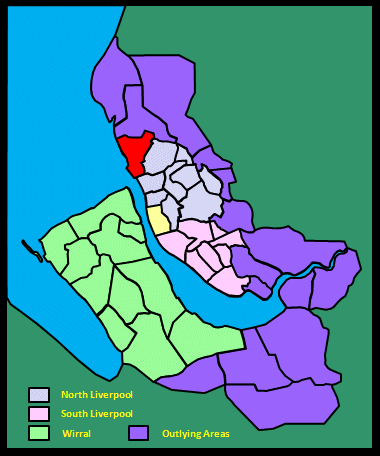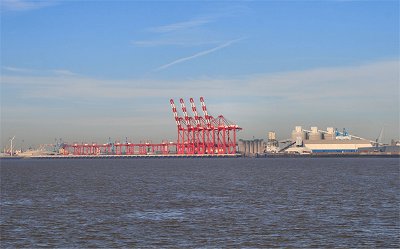 |
Seaforth
Container Port
Royal Seaforth Dock is a
purpose-built dock and container terminal. Work on it
began in the 1960s and it became Liverpool's largest dock
and, at the time, the largest in the UK. It is connected
to neighbouring Gladstone Dock, which provides an
entrance to the river via its lock system. The site
covers 5000 acres (2000 ha) with 85 acres (34 ha) of
water. Liverpool 2, undergoing a phased opening from
2016, will double the container capacity of the port by
admitting all but the very largest container ships. |
Seaforth in Liverpool
(1907) by Dixon Scott
As for Seaforth itself, [...] it, naturally, is the least
personable of [the chain of northern seaside
settlements]. 'The slums of the future', say the
pessimists sententiously; and already a notable greyness
begins to creep over its tightly packed workmen's
cottages. It seems especially deplorable, for the shore
of the place (unbelievably peppered in the summer heats
with naked pinkish youngsters) is clean and fair enough;
New Brighton glitters pleasantly across the estuary, the
Welsh hills heave up in the distance, and the great ships
of the world promenade before its parlour windows. |
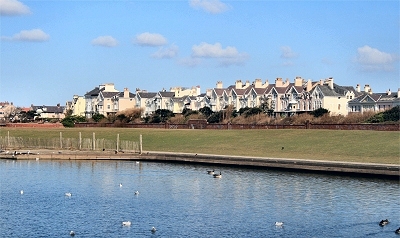 |
Sea
Captains' Villas, Waterloo
Elegant Victorian Villas (completed mid-1870s) on the
seafront at Waterloo from Crosby Marine Lake with the
walled public gardens in front. They are known locally as
the Sea Captains' Villas. Thomas Henry Ismay, founder of
the White Star Line, built one for himself in 1865 and
was behind the development of some of the others.
Waterloo takes its name from the Royal Waterloo Hotel
(now simply the Royal Hotel) of 1816, which opened when
the area was first becoming of interest as a bathing
resort. When I was a kid in the 1950s, you walked down
between the gardens at the end of South Road and the
beach was just there; it reached right up to Gladstone
Dock to the south. There were pyramidal concrete tank
defences along the shore. During the 1960s, this area was
subject to redevelopment on a huge scale, with the
construction of Seaforth Freeport (opened 1972), the
Marine Lake and the waterfront promenade. |
 |
Waterloo in Lewis's
Topographical Dictionary of England (1848)
This village is beautifully situated on the coast, near
the mouth of the river Mersey. It is a favourite
sea-bathing place, remarkable for the firmness of its
sands, the clearness of the water, and salubrity of the
air; and is much frequented by families from Liverpool.
The village consists of several ranges of commodious
houses, a fine marine crescent, and some excellent
hotels; commanding prospects of the entrance to the
Mersey, and the port of Liverpool, with parts of
Cheshire, and the northern coast of Wales. |
The view at Crosby in Liverpool
(1907) by Dixon Scott
[...] a bold and various prospect. On the one hand the
level floor of the sea, here dusked, there silvered,
marbled by voyaging clouds, runs out until it meets a
wide pure sky. Poised at the western extreme of the long
horizon blade, Anglesey rests like a sapphire, and the
hem of all the air that sweeps away to the south is
braided thereafter by the woven hills of Wales. From them
the eye stoops successively to the shimmering aura of the
Dee, to the embossed interspace of the Wirral, to the
bright-mailed river down below. [...] Unfolding between
[the] spreading blackness [of the city] in the south and
a rim of purple woodland in the north, a fair carpet of
meadowland and cornfield runs clear and away. A rare
white farm or so, set in that green tranquillity, invest
it with a kind of homely joy. |
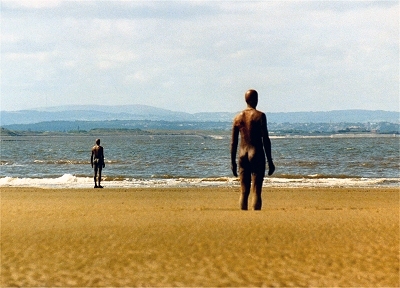 |
Antony
Gormley's Another Place,
Waterloo
In front of the waterfront promenade at Waterloo there is
a fine long stretch of golden sand that is usually almost
empty. Here there are superb views over the sea towards
the Wirral and North Wales. This is the appropriate
setting for the start of Antony Gormley's haunting
shoreline installation Another Place: 100 life
size rusting cast iron figures gazing out to sea from
here to the estuary of the River Alt. |
 |
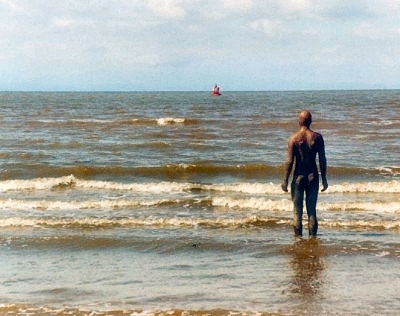 |
Antony
Gormley's Another Place,
Waterloo |
 |
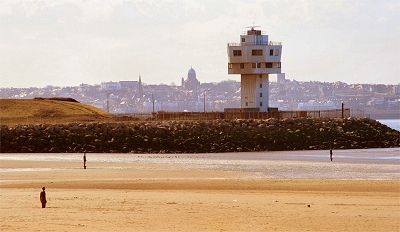 |
Crosby
Radar Station and New Brighton |
 |
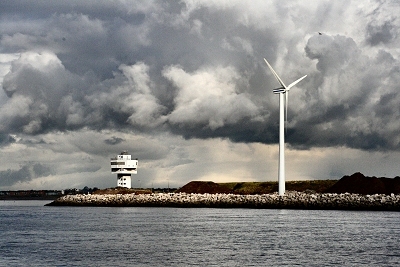 |
Crosby
Radar Station |
|
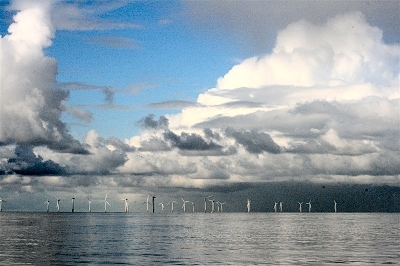 |
Wind
Turbines off the Crosby Shore
Modern day wind turbines are, of course, used to drive
dynamos to generate electricity. The first such was the
work of the Scot James Blyth, who used wind power to
charge batteries to light his home, and they remained a
competitive source of electricity in isolated areas for
many years. The first wind turbine connected to the
electricity grid was built by John Brown and Co. in
Orkney in 1951. The huge recent growth in wind turbines
is due their 'green' credentials: they are a renewable
source of energy with low climate impact (only in
manufacturing). They remain controversial. Production
costs are high, energy return from wind is much lower
than from water (hydroelectric or tidal) and the visual
impact on the environment often regarded as undesirable. |
|
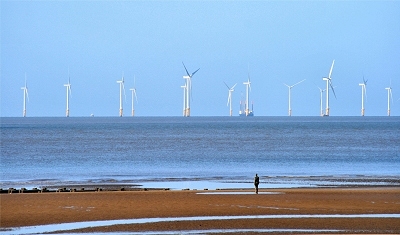 |
Wind
Turbines off the Crosby Shore
A scouse joke follows: A scouser is taking his dog (one
eye, a chunk missing from one ear, mange, a limp - you
get the idea) for a walk along the shore at Crosby one
day when he sees a rusty-looking object lying on the
tide-line. He gives it a peevish kick and there's a puff
of smoke and out pops a genie. Genie: 'I am the Genie of
the Lamp! Your wish is my command!' Scouser: 'Nice one
mate! Er, 'ow about fixin' it fer Tyson 'ere ter win at
Crufts?' Genie: 'Ah, my powers are indeed great, but
there are limits to what even I can achieve.' Scouser:
'Er, let's 'ave a tink den. I know, 'ow about gerrin'
Everton (Liverpool, Tranmere, depending upon your
audience) to win The Cup?' Genie (after a pause): 'Let's
have another look at that dog.' |
 |
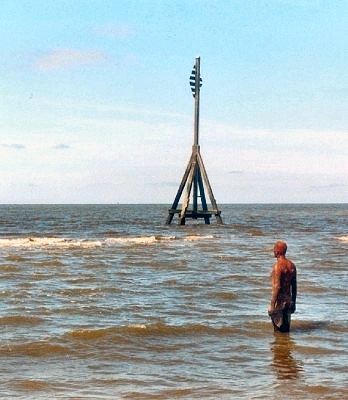 |
Antony
Gormley's Another Place,
Hall Road
As kids in the 1950s, we used to paddle and bathe here,
but I hate to think what the state of the water was back
then. Tiny little shrimp-like creatures used to nip at
us. Still, it's all good for the developing immune
system, I suppose. Everything is much cleaner now, of
course. |
 |
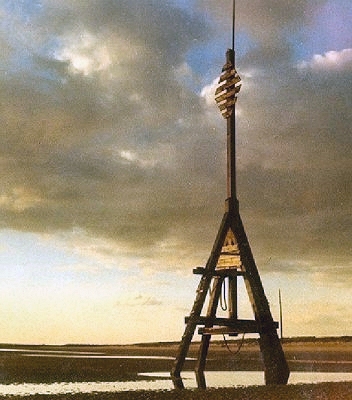 |
Landmark
near Hall Road
An old landmark on the Irish Sea shore just north of
Liverpool. This is one of two measured mile markers (the
other, at Crosby, no longer there) once used by shipping
to calibrate their speed instruments when leaving the
Mersey estuary. (My thanks to Paul Fairfield for this
information.) |
 |
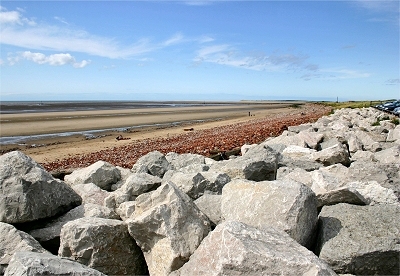 |
The
Shore North of Hall Road
This is the view north from Hall Road to Hightown showing
the sea defences. My thanks to Don Garton for this and
the following picture (and his thanks to Ansel Adams, no
doubt). |
 |
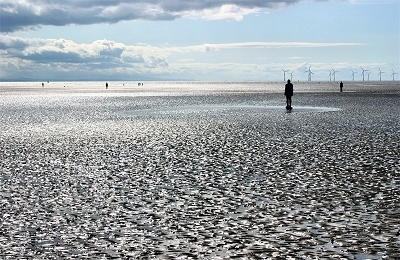 |
The
Shore at Hall Road
An atmospheric shot over the sands. |
 |
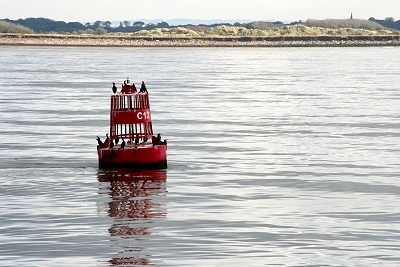 |
A
Bouy off the Crosby Shore
With cormorants. |
|
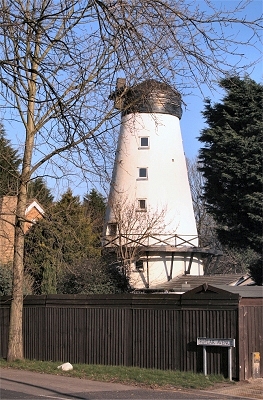 |
The
Old Mill, Great Crosby
The Old Mill, located at Great Crosby's highest
point, dates from 1813. |
|
Great Crosby in the Victoria
History of the County of Lancaster (1907)
The ancient township of Great Crosby, which includes
Waterloo, lies on the northern shore of the estuary of
the Mersey, with a level sandy beach extending over three
miles from north-west to southeast [...]. The country is
flat and sandy, being in places still very marshy, so
that deep ditches, especially in the north, are required
to drain the fields and meadows. The crops grown are
principally oats, rye, and potatoes. At Hall Road there
are golf-links on both sides of the railway, and a broad
stretch of sandhills, yet unbuilt upon, extends along the
northern half of the sea coast. [...] The village, which
lies more than a mile inland, is becoming modernized and
growing quickly [..]. An electric tramway connects Great
Crosby with the Seaforth terminus of the Liverpool
Overhead Railway. The township of Waterloo has been
carved out of the southern part of Great Crosby. To the
north of it are Brighton le Sands and Blundellsands;
these places consist principally of modern residences,
which afford Liverpool people convenient dwellings at the
seaside. [...] Crosby Channel forms the principal
entrance to the Mersey; it is about three-quarters of a
mile wide. By constant dredging a sufficient depth of
water for the passage of the great liners is maintained.
There is a lightship in the channel. [...] The Crosby
races used to be held once or twice a year - the first
week of August was the proper time - on a course on the
shore side of Great and Little Crosby [...]. The little
triangular green of the village is now paved. Here is the
ancient St. Michael's Well, which has been covered in,
and is surmounted with steps and a wooden cross. |
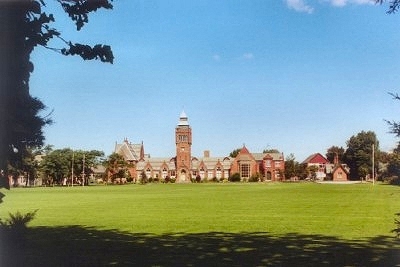 |
Merchant
Taylors School, Great Crosby
A Merchant Taylors School was first established in Crosby
in 1620. This is now the girls' school. This Gothic
building, the boys' school, just down the road, dates
from 1878. It was your devoted writer's alma mater from
1961 to 1968. I recall the teachers in the 60s being a
mixture of the progressive and the Dickensian. I'm still
impressed with being asked for English homework in 1963
to write scenes in the style of Harold Pinter and Eugene
Ionesco (then considered avant garde), and with
being played records of Bartok string quartets by one of
the physics teachers after sixth form exams were over. I
was taught Latin, on the other hand, by a follower of
Wackford Squeers. |
|
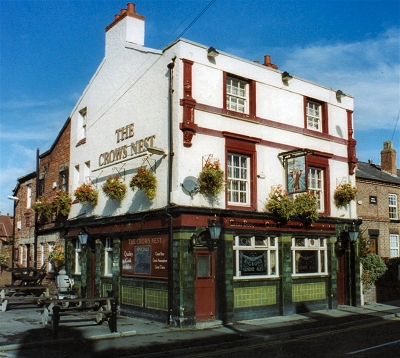 |
The
Crow's Nest, Crosby
A traditional suburban local, nicely appointed inside and
out. Crosby is not exactly awash with decent pubs and
this one is most welcome. |
|
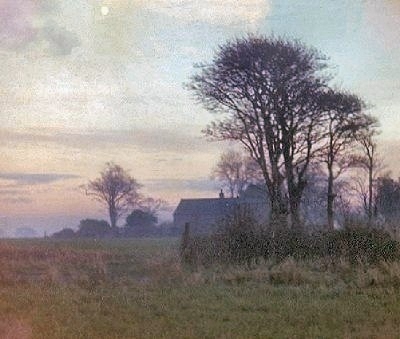 |
Farmland
near Thornton
Thornton is at the extreme northern edge of the Liverpool
conurbation. This is typical of the flat agricultural
land that starts here, bleak and brooding on a freezing
winter's afternoon. About 100 years ago it is said to
have been a village much resorted to by pleasure parties.
Slightly more recently it was where Iived as a teenager. |
|
Thornton in the Victoria
History of the County of Lancaster (1907)
This township [...] is situated in flat country
consisting of pastures and cultivated fields. The soil is
loamy, producing crops of potatoes, turnips, and corn.
The pastures near the Alt lie very low and are often
flooded in winter-time and wet seasons. Trees are not a
prominent feature of the open landscape. [...]. In the
summer the village is much resorted to by pleasure
parties. The road from Sefton to Great Crosby passes
through it. To the north-east is a hamlet now called
Homer Green, formerly Hulmore. There is the pedestal of a
cross called Broom's Cross. An ancient sundial on a stone
pillar stands on Thornton Green; close to it are the
stocks. Dialect words in colloquial use which may be
noticed here are 'neave' for fist, 'narky' for fractious
[surely more widely used?], and 'coi ammered' or 'cain
ammered' for testy or contentious. |
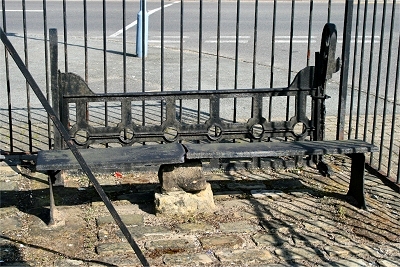 |
Stocks,
Thornton
The present Thornton stocks date from 1791, when they
replaced an earlier set. They continued in use as late as
1863. The damage visible was caused when a truck collided
with them during a blackout in World War II. |
 |
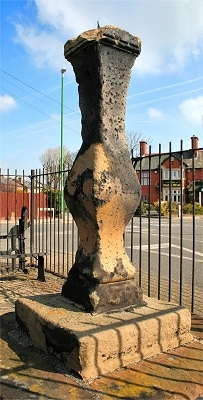 |
Sundial,
Thornton
Sundials were a common feature of Lancashire villages.
The sundial here in Thornton predates 1720, making it
possibly the oldest surviving example in south-west
Lancashire. |
 |
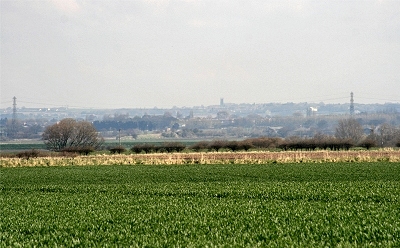 |
Aughton
from Broom's Cross, Thornton
This is the view towards Aughton from Brooms Cross. The
pedestal survives of an ancient resting place for coffin
bearers en route to Sefton Church. |
 |
